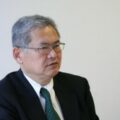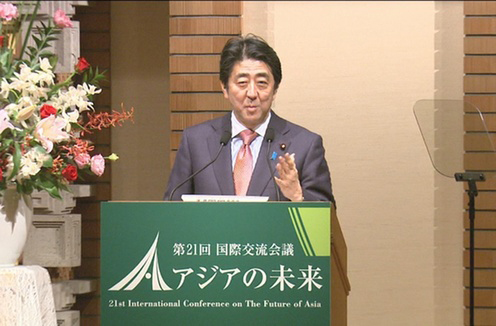The region is a stage. Yosakoi Soran Festival (Sapporo, Hokkaido)Pageant of Lights and Sound — Witness the power of group dancing, and the moment when human bodies shine.
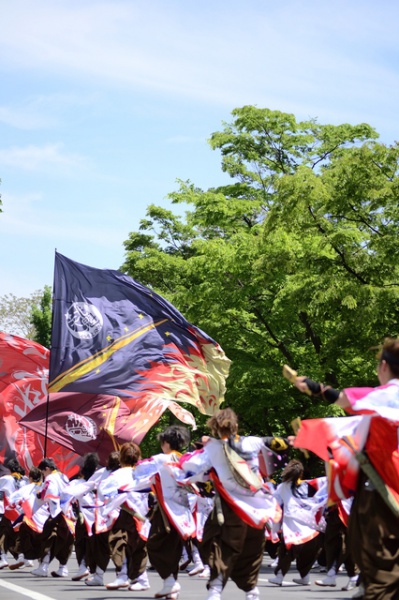
The parade along Odori Avenue runs north to south through central Sapporo.
Famous Event in Sapporo
The final stage in Odori Koen Park played host to twelve teams that had won a series of tournaments. Each team gave a riveting and spectacular dancing performance when they took the stage, which transformed into a powerful pageantry of people, sound, and lights that echoed across the sky. It didn’t take long for the spectators to become increasingly drawn in by the performances, just like when people watch an exciting game. They roared in delight upon seeing the performers quickly change their original costumes in unison. They were not merely watching dancing performances. All of them had been unconsciously brought together and made to take part in a contest that would determine this year’s winner. There was a sense of euphoria everywhere. Performers and spectators alike shared the joy of melting into one, raising their voices to give a shout stemming from the wave of emotions welling up from deep within their trembling bodies. This feeling can only be truly understood by those who experience it. Indeed, they were there to enjoy the moment.
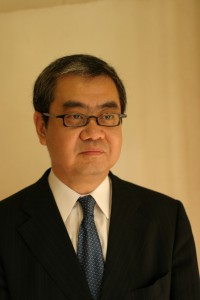
Mikuriya Takashi, Professor, The Open University of Japan
I am reminded again how happy and invigorating it is to express something by moving your body. When we encounter a person that moves dynamically, we unconsciously stop to watch. In the same way, our eyes were glued to the parades — led by jikatasha vehicles, or trucks decorated and equipped with sound equipment — as teams danced in groups all day on Odori Avenue. Before I knew it, I found myself spontaneously shouting “hang in there” to groups in the parade who looked physically tired from dancing at many places, but still exhibited a sense of excitement. I then wondered what it was that attracted people to this dazzling scene of bodily expression. Was it the parade? The stage?
The festival has become an annual special event in Sapporo, Hokkaido, and is held right at the beginning of summer. For the first few days of June, every street in Sapporo gets caught up in the excitement of the Yosakoi Soran festival. The festival, which was held for the 23rd time this year, began in 1992. In that sense, it is an all-new festival with no connection to traditional regional culture. First of all, it is a hybrid man-made festival performance based on the use of the naruko, a musical instrument used in the Yosakoi Festival, and “Soranbushi,” a Hokkaido folk song. It was largely the creation of Hasegawa Gaku, a Hokkaido University student who was captivated by the Yosakoi Festival in Kochi.
Yosakoi Soran Festival
|
This festival was launched in 1992 by a group of students inspired by the Yosakoi Festival in the city of Kochi, Kochi Prefecture. Participants are free to dance as they please, with the only rule being that they hold naruko clappers and call out “Soran, Soran,” a phrase originating from the Hokkaido folk song “Soranbushi.” Participants are also expected to create all their own music, costumes and dance movements. The 23rd Yosakoi Soran Festival in Sapporo, held over five days from June 4 to June 8, 2014, welcomed 27,000 participants from Hokkaido and other parts of Japan and 2 million spectators. The Yosakoi Soran Festival Organizing Committee plans and manages the festival with the support of 4,000 citizen and student volunteers. The photo here depicts a dance performance of “Yumesoren Esashi” (Fantasy Waves of Esashi) from Esashi-cho, Hokkaido, which was selected as the winner of the 23rd Yosakoi Soran Grand Prix. The Yosakoi Soran Organizing Committee: YOSAKOI Soran Festival, Sapporo TourismOffical Website: |
Reflecting the Times
The festival was created at the end of the twentieth century and evolved over the course of the early years of the twenty-first century. The two decades since the festival was established have been an intense period of political, economic and social change for Japan. These changes have had an unmistakable impact on the festival.
Going back thirteen years from now to the time I became involved with the regional culture research initiated by the Suntory Culture Trust, the Yosakoi Soran Festival I encountered was truly captivating.
Hasegawa Gaku, the leader of the new festival, was a shining star. He seemed to be surrounded by an aura. He now has an active political career as a member of the House of Councilors. The festival, which soon became too big for him to run, is now managed by one of the large organizations in Sapporo (Yosakoi Soran Festival Organizing Committee). Even so, it remains a student-driven festival. The festival has undergone a series of gradual changes over the years, overcoming different trials and tribulations while remaining true to its initial goals.
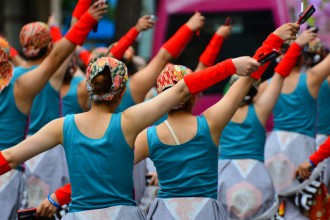 |
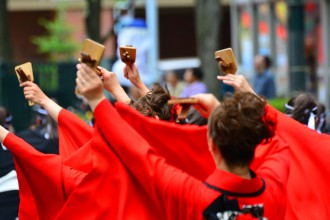 |
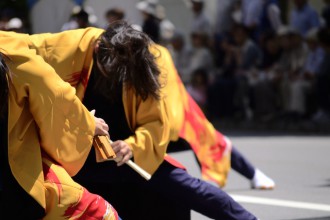 |
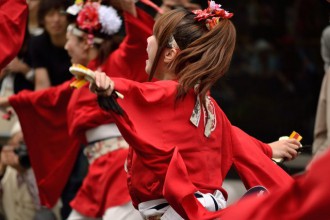 |
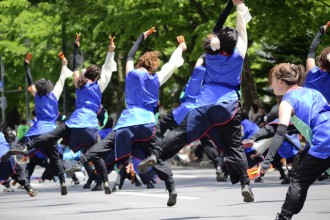 |
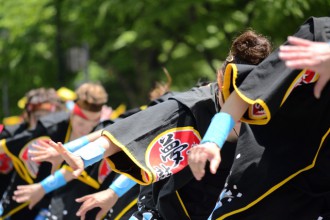 |
| The naruko clappers required for dancing in their hands. Teams compete against each other in elaborately designed costumes and accessories. 270 teams competed to won the final stage where only 12 teams perform for the Grand Prix. | |
Change to a festival famous for its long-standing tradition occurs when signs of decline become noticeable. Likewise, tradition and change can become locked in a tug of war when the baton is passed from one generation to the next. The Yosakoi Soran Festival is carried out in a way that is totally different from how regional cultures steeped in long-standing tradition have lived. To begin with, it is debatable whether the festival really represents a form of regional culture. It is simply an event sprouted out of the blue in a major city like Sapporo. For this reason, people have striven to prove over the last twenty years that this festival is more than a fleeting event that suddenly vanishes. At the same time, they have demonstrated its ability to change, a fact perfectly reflected in the changing contrast of the bold and delicate expressions of the dancers. As the scale of the festival has expanded, it has always run into difficulties. There have been problems with administrative offices, police and economic organizations, and at times even the inhabitants of Sapporo. Frustrated with the jam-packed avenues and closed streets, one taxi driver clicked his tongue and said, “We have no business.” Even then, he did not totally disapprove of the festival.
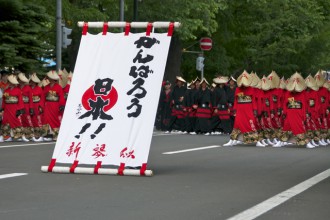 |
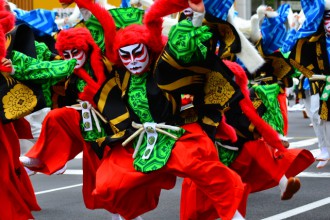 |
In short, the organizers have succeeded in making the Sapporo Soran Festival an established event here in as little as twenty years, and have exhibited the agility of a flexibly structured organization. But it is important to reflect here on some of what has happened. The number of participating teams has been on the decline since 2001. After the burst of the economic bubble, there was a decrease in the number of teams sponsored by companies or made up of non-students. The number of teams that continue to perform in small towns across Hokkaido has also dropped. These towns have suffered from the problems related to depopulation and an aging society with fewer children, just as in other regions in Japan. These trends indicate that it is really hard for festivals to revitalize towns. This seems to be linked to the transformation of Japanese society.
That being said, the number of student-based teams or participating teams from outside Hokkaido is on the rise, demonstrating an increase in the number of younger and mid-career generations eager to carry on the festival. The increase is an important factor contributing to the transformation of the physical expressions seen in the Yosakoi Soran, making them more colorful and diverse. Other notable trends in recent years are the participation of junior high and elementary school students and the enhanced level of performances. It is clear that an environment ideal for continuing festivals is being improved, as is witnessed by the addition of dance to other forms of physical expression to the elementary school curriculum.
In addition, the methods for judging the performances have become more “mainstream” and “diverse.” There were times it was feared that professional judging would lead to stereotypes that would cause the festival to lose its dynamism. Faced with this dilemma, the organizers adopted a more amateur approach and sought to make the festival a nationwide event, allowing judges to be chosen from the greater public and lowering the minimum age to junior high school students. As a result, the top teams are now more evenly selected. It is clear that the democratization of the festival is under way, just like with the judicial system following the introduction of a lay judge system.
In terms of managing the festival, the number of student members on executive committees has increased. Likewise, a process has been established so that current members, many of whom participated in or watched the Yosakoi Soran Festival when they were children, can become members of the executive committee they long to join. Everything is clear now. We are seeing tradition being built, a process in which the young are trained to carry on this event.
The Heisei Youth
However, there is a troubling phenomenon among today’s youth. Simply put, there are no students who exert a sense of leadership. Nobody is willing to serve as chairman of an executive committee. Individuals who take the position cannot make decisions on their own or persuade other members to follow them. They merely share proposals from the Organizing Committee and work as a coordinator to make decisions by majority. This is a serious problem. When I interact with university students, I see the same phenomenon in seminar classes and circles. Since they get together to build casual relationships, they keep a low profile, while trying to be liked by and get along with everybody. They will never be able to make any important decisions unless they let go of this attitude.
These traits of young people have only become noticeable in the last twenty years. I truly believe one of the reasons Japanese politics and the economy have shown no signs of revitalization is that people prefer the sense of security felt when led by a strong individual or organization. What has come of Hiragishi Tenjin — a dancing team that was organized around the time the Yosakoi Soran Festival started and which has won eight times, the most of any team — during the last few years? Essentially, I wanted to hear the voices of the very people who have worked for years to revitalize the Hiragishi Shopping District community. I wanted to ask them how they keep up with the “ke” (daily routines and preparations), for which the success of “hare” (festival days) depends.
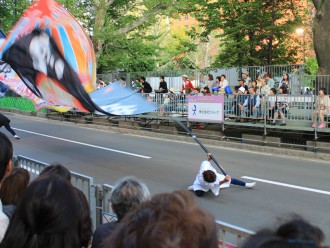 |
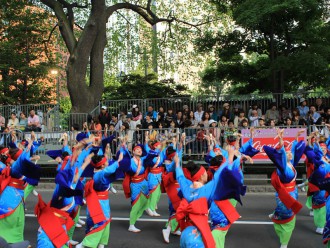 |
| BOTH PHOTOS: 芳菲 | |
Here again, the focus of discussion is on young people and how to develop human resources. Eighty percent of the current members were born in the Heisei period (1989–). Basically, it is the Heisei youth who are running the Festival, although the number of young people with the taiiku-kei (athletic) mindset cultivated in the sports clubs of Japanese universities has decreased. Instead, it is the so-called ordinary kids — those who are not comfortable with working as a team and prefer to go it alone — that join the team. It has trouble conducting activities with the same group of members because many kids quit as soon as they feel uncomfortable. There is concern that the number of “master” members with ten to fifteen years’ experience is decreasing. These kids are a lot like the young people working for private companies or government offices who get angry and quit suddenly.
Furthermore, as I mentioned in the part about the students’ executive committee, there are no leaders. They are perfectly happy getting along with each other, and do not try to take any action until they are told to do so. The emergence of individuals willing to take on responsibilities is a matter of grave concern because the team is currently managed by former members who are in their thirties and forties. However, I am confident that the Hiragishi Tenjin team will focus its efforts on carrying on the Yosakoi Soran Festival, taking advantage of the unique experience and knowledge it has gained as one of the original participating teams. After all, stubborn endurance is one trait of tradition.
When I think of the Yosakoi Soran Festival, I automatically start feeling like a frequent visitor who desires to relive those moments of excitement. Soon, I come to realize the mysterious modernity that only lies within festivals. Currently, new events modeled after the Yosakoi Soran Festival are being created and developed in many parts of Japan. Some young people who were involved in the festival, such as Hasegawa Gaku, are actively pursuing political careers, and it seems they will become influential players in the future. Now I see. The Festival is still evolving.
Translated from “Special Feature: Kyoyu sareru Nihon Bunka―Manga wa Korin wo koeru (Special Feature: Shared Japanese Culture―Manga Will Surpass Korin),” AΣTEION, Vol. 081 2014, pp. 136-143. (Courtesy of CCC Media House Co., Ltd.) [November 2014]



